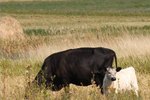Things You'll Need
Feeding tube with feeding bag
Tape measure
Tape
Helper
Colostrum/electrolyte fluids
Calf
Warnings
Never force the tube down the calf's throat, since this can cause the tube to enter the calf's trachea.
Feeding a calf with a feeding tube, a process commonly called stomach tubing, is a skill that every cattle owner should have. Frequently, baby calves are born extremely weak and unable to nurse. Since these little ones must have colostrum (the nutrient-rich milk a cow first produces after giving birth) within hours of being born, stomach tubing them is often the only feeding option that keeps them alive. Another common situation that requires stomach tubing occurs when your baby calf develops scours or diarrhea and won’t eat. Without stomach tubing electrolyte fluids, rapid dehydration and death typically result.
Acquire a feeding tube designed specifically for calves from a livestock supply company or catalog. A feeding tube typically consists of a sheath of pliable plastic tubing that is often attached to a plastic feeding bag at one end. According to R. L. Morter, DVM, from the School of Veterinary Medicine at Purdue University, the tube should contain a large bulb on the end to reduce your chances of passing the tube into the calf’s trachea.
Determine how much of the tube you need to insert. Using a tape measure, calculate the distance from the calf’s nose to the point of its elbow on its front leg. Measure this distance on the feeding tube starting at the tip of the bulb; wrap a strip of tape around the feeding tube to mark the length of tube that you need to insert.
Fill the feeding bag with the warm liquid (usually colostrum or electrolytes) that you will be tubing. Have your helper clamp or pinch the tube right below the feeding bag so you can pour in the liquid slowly without having it leak out the other end of the stomach tube.
Restrain the calf. If the calf is active, straddle its neck, placing your legs on either side so you’re facing in the same direction as the calf. If the calf is weak, you should be able to simply wrap your arm around its head, cradling its jaw to limit sudden head movements.
Insert the stomach tube. Gently open the calf’s mouth and slide the stomach tube along the length of the tongue toward the left side of the throat. At this point, the calf usually will start swallowing the tube, which allows it to pass easily into the esophagus. Let it continue to slide in until you reach the tape-marked section of the tube.
Check for correct tube positioning. Gently palpate the calf’s neck; you should be able to feel both the enlarged esophagus (which contains the feeding tube) and the trachea (which should have distinctive raised rings) next to each other. If you can’t feel both of these, remove the tube and re-insert it.
Have your partner raise the feeding bag into the air and release the other end of the feeding tube so the liquid can pass slowly into the calf’s stomach, minimizing chances of regurgitation.
Remove the feeding tube slowly. Don’t forget to wash and sanitize the stomach tube and feeding bag before hanging them up to dry.
References
Warnings
- Never force the tube down the calf's throat, since this can cause the tube to enter the calf's trachea.
Writer Bio
Regan Hennessy has been writing professionally for 11 years. A copywriter and certified teacher, Hennessy specializes in the areas of parenting, health, education, agriculture and personal finance. She has produced content for various websites and graduated from Lycoming College with a Bachelor of Arts in English.





